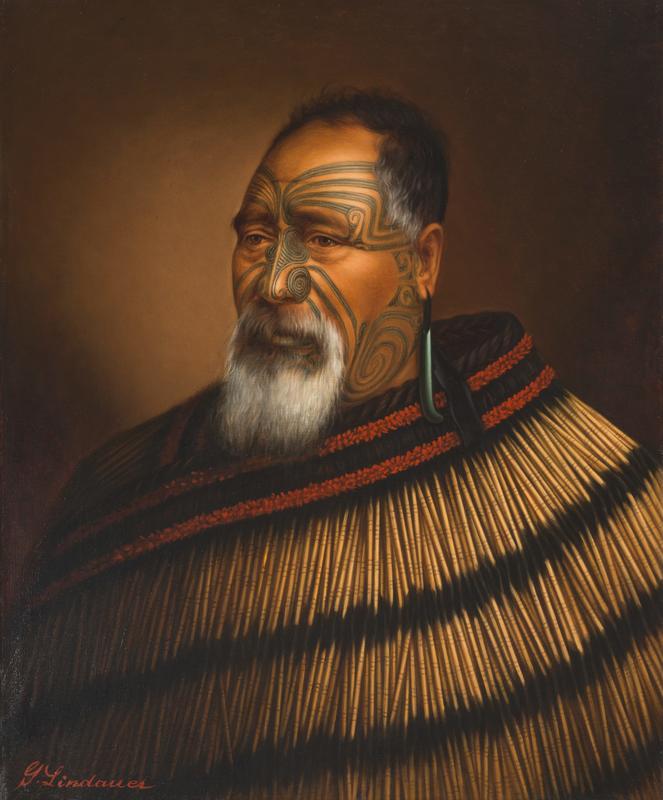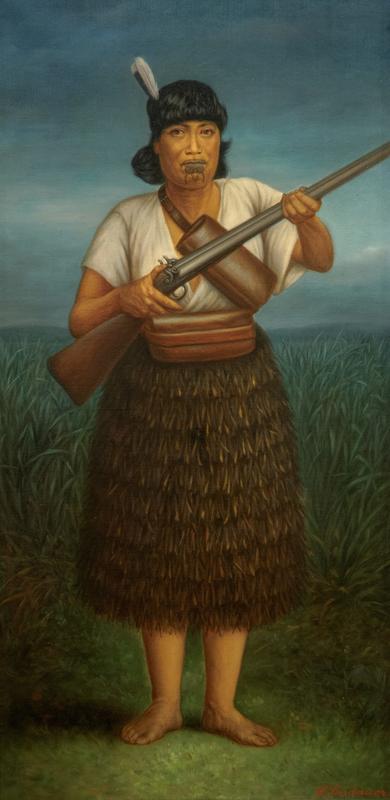—

exhibition Details
Enduring Nature: Hoki Atu Hoki Mai looks at the particular character of Aotearoa New Zealand's flora and fauna and the resilience of its people. Dutch explorer Abel Tasman visited here in 1642 and subsequent voyagers such as James Cook and Jules Durmont d'Urville stayed for periods, recording what they saw and who they encountered. As draftsmen their accounts were more scientifically driven, recording ecological and botanical findings for political and economic ends.
New Zealand's majestic beauty was recognised early in its history, as demonstrated by the interest shown in two tableaux depicting Milford Sound and Lake Wakatipu by the Melbourne based artist Eugene Von Guérard. These works toured Paris, Sydney, Melbourne and London from the late-1870s through to the mid-1880s. What makes Von Guérard's painting of Lake Wakatipu with Mount Ernslaw, Middle Island New Zealand unique from a scene of the Swiss or Italian Alps is not only the canoe crossing the waterway but also his faithful portrayal of toetoe, flax and cabbage trees which line the near shore.
Through the paintings of John Hoyte and Albin Martin we are offered an idealised view of the land. In contrast Alfred Sharpe's paintings show some of the harsher realities of what it was actually like to live here in the mid-to-late 19th century; a hand-to-mouth existence isn't hard to imagine. The scenery is typically portrayed as 'waiting to be occupied' and a range of locations illustrate what settlers might expect to see, including settlements and the burgeoning gold mining and logging industries, with its consequent environmental damage. European dwellings, imported flora and animals start to appear in paintings as Maori and native flora and fauna progressively disappear. Material progress and nation building were ideals that settlers brought with them to New Zealand and early artists were influential in advancing these foundational notions.
At the same time books such as Walter Buller's A History of the Birds of New Zealandand Joseph Dalton's The Botany of the Antarctic Voyage, on loan to this exhibition from Auckland City Library's Special Collections, catalogued New Zealand's inimitable flora and fauna. As later generations of artists, such as Percy Bagnall and Trevor Lloyd, were born and raised in New Zealand they turned to these subjects in an effort to establish a New Zealand identity, distinctly separate from England. These subjects have been further explored in works of later artists such as Gordon Walters and Richard Killeen.
Visual records draw us back to accounts of our ancestors and their involvement in New Zealand history. They capture the relationships our forbears had with nature and each other, providing us with knowledge and positive legacies of who we are and where we came from. They are a source to return to generation after generation, hoki mai hoki atu.
- Date
- —
- Curated by
- Ngahiraka Mason and Jane Davidson
- Location
- Main Gallery
- Cost
- Free entry
Related Artworks
Pukeko
colour lithograph
Auckland Art Gallery Toi o Tāmaki, transferred from the Auckland Public Library, 1932
Manuka
woodcut
Auckland Art Gallery Toi o Tāmaki, gift of Josephine K Forbes in memory of her uncle, John L Moore, 1991
Te tangi o te moa
watercolour, gouache
Auckland Art Gallery Toi o Tāmaki, bequest of Miss Connie Lloyd, 1983
A View in Dusky Bay, New Zealand
On display
Black Backed Gulls
colour lithograph
Auckland Art Gallery Toi o Tāmaki, transferred from the Auckland Public Library, 1932
Pied Shag
colour lithograph
Auckland Art Gallery Toi o Tāmaki, transferred from the Auckland Public Library, 1932
Evening Mahinapua Creek, Hokitika
oil on canvas
Auckland Art Gallery Toi o Tāmaki, gift of the Auckland Society of Arts, 1912
The Mountain's Crown, Kauri Bush, Whangaroa
oil on canvas
Auckland Art Gallery Toi o Tāmaki, gift of S Vaile & Sons with other Auckland citizens, 1919
Lake Wakatipu with Mount Earnslaw, Middle Island, New Zealand
oil on canvas
Mackelvie Trust Collection, Auckland Art Gallery Toi o Tāmaki, purchased 1971
Gold Mining, Thames
watercolour and gouache
Auckland Art Gallery Toi o Tāmaki, gift of Mr Norman B Spencer, 1967
Tuhoto Ariki
On display
Tukukino Te Ahiātaewa
On display
Paratene Te Manu
On display
Mahoe
woodcut
Auckland Art Gallery Toi o Tāmaki, gift of Josephine K Forbes in memory of her uncle, John L Moore, 1991
Rangiora
woodcut
Auckland Art Gallery Toi o Tāmaki, gift of Josephine K Forbes in memory of her uncle, John L Moore, 1991
View of Taupiri village and plain from the top of Little Taupiri Hill. Sunset
watercolour painting, paper manuscript
Auckland Art Gallery Toi o Tāmaki, gift of the Rev Charles Palmer, 1951
Portrait of Sir John Logan Campbell
oil on canvas
Auckland Art Gallery Toi o Tāmaki, gift of the Auckland Picture Purchase Fund, 1910
Unidentified landscape (Schoalhaven)
oil on canvas
Auckland Art Gallery Toi o Tāmaki, The Ilene and Laurence Dakin Bequest, purchased 1997
The Titoki, A Forest-tree
hand-coloured lithograph
Auckland Art Gallery Toi o Tāmaki, purchased with funds from the M A Serra Trust, 1987
The Taua, A Large Forest Tree
hand-coloured lithograph
Auckland Art Gallery Toi o Tāmaki, purchased with funds from the M A Serra Trust, 1987
The Tutu (Commonly Called Toot)
hand-coloured lithograph
Auckland Art Gallery Toi o Tāmaki, purchased with funds from the M A Serra Trust, 1987
The Rata in Flower
hand-coloured lithograph
Auckland Art Gallery Toi o Tāmaki, purchased with funds from the M A Serra Trust, 1987
The Phormium Tenax, or New Zealand Flax
hand-coloured lithograph
Auckland Art Gallery Toi o Tāmaki, purchased with funds from the M A Serra Trust, 1987
Arrival of Captain Cook; An incident in the Bay of Islands, 29 November 1769
oil on cardboard
Auckland Art Gallery Toi o Tāmaki, gifted in memory of Frank Anthony Eden, 1988
Keeta
On display
Pikirakau
On display
Day Dreams, Christmas time in Maoriland
oil on canvas
Auckland Art Gallery Toi o Tāmaki, gifted in memory of Frank Anthony Eden, 1988
Hamiora Tu
On display
The Story of a New Zealand River
paua, capiz, lacquer and wood on a concert grand piano
Auckland Art Gallery Toi o Tāmaki, gift of Thanksgiving Foundation, 2023
The Gold Mining Town of Karangahake
pencil, watercolour and opaque white
Auckland Art Gallery Toi o Tāmaki, purchased with funds from the M A Serra Trust, 1983
Morepork
colour lithograph
Auckland Art Gallery Toi o Tāmaki, transferred from the Auckland Public Library, 1932
Pied Fantail
coloured lithograph
Auckland Art Gallery Toi o Tāmaki, transferred from the Auckland Public Library, 1932
Clematis, female
woodcut
Auckland Art Gallery Toi o Tāmaki, gift of Josephine K Forbes in memory of her uncle, John L Moore, 1991
Clematis, male
woodcut
Auckland Art Gallery Toi o Tāmaki, gift of Josephine K Forbes in memory of her uncle, John L Moore, 1991
Mingi-mingi
woodcut
Auckland Art Gallery Toi o Tāmaki, gift of Josephine K Forbes in memory of her uncle, John L Moore, 1991
Coromandel Harbour
watercolour and gouache
Auckland Art Gallery Toi o Tāmaki, gift of Mr Norman B Spencer, 1966

























































































